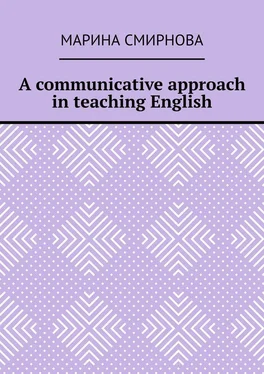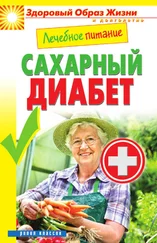A communicative approach in teaching English
Марина Смирнова
© Марина Смирнова, 2021
ISBN 978-5-0053-8817-9
Создано в интеллектуальной издательской системе Ridero
Dear collegues!
This guide is intended to be used by the teacher of English to make their lessons more effective, creative and teach students to communicate and use English in real life.
I have included all the practical aspects of a communicative approach, its main ideas, methods and techniques and provided the examples of tasks for different levels into this brochure.
I have also attached the examples from my own teaching practice which I successfully apply at the lessons.
You can use them and create your own tasks!
The communicative approach. Its principles
The main approaches to teaching English at school today are grammar-translation and communicative ones.
Most teachers use a grammar-translation method the essence of which is to translate everything into Russian, explain grammar in Russian and do exercises which we call «drills» to practise your language skills.
The drawbacksof such an approach are clear to everyone:
– the students do not get used to speaking English as the teacher and they mainly speak Russian at the lessons,
– the students memorise and learn everything by heart without understanding how to use these constructions in real life,
– the language barrier is large as they don’t communicate and don’t pay much attention to speaking and listening to native speakers.
Nowadays the communicative approach has spread largely in schools, and advanced teachers prefer using it.
Its undisputable advantages are:
– lifelike situation at the lessons,
– the creation of the speaking environment,
– the reproduction of all new structures into speech,
– the practical use of the language.
The principlesof the communicative approach are:
– imitating real speaking environment,
– speaking English all the time,
– emerging students into communicative situations,
– encouraging students to talk,
– concentrating more on the speech,
– teaching grammar in context,
– being positive, creative and democratic with the students.
Your first goal is imitating real speaking environment by means of creating communicative situations.
Here are some examples.
Situation 1.
Students – pre-schoolers
Topic: «Toys»
The aim of the task – to remember the words and the phrase: «give me…»
The students have the cards with the toys, they need to complete the full row: the teacher puts the row on the board: a ball, a doll, a car, a soldier. Each student has a card with one toy missing. They need to ask a teacher: «Give me a … (missing card) ” and complete their row.
Situation 2:
Students – adults (elementary)
Topic: «Daily routines»
The aim of the task – to practise Present Simple statements, the question «What time do you..?», remember daily routines.
The students are to make a poll. They can see cards with everyday actions on the board. They ask their partners questions such as «What time do you … (get up)?» and write down their answers on the blank. Then they need to tell the class about their partner: «Mike gets up at 6 a.m., he has breakfast at 8 am…»
The communicative situation imitates real life conditions provoking students to talk.
If these are small kids, it is enough to imitate primitive situations with short simple phrases and sentences. If the students are grown-ups, you need to choose relevant topics and interesting circumstances.
The second important principle is to speak Engish at the lessons. It is difficult to make it understandable for young learners and beginners what to do speaking only English. The tipshere may be:
– simplifying the lenguage without using difficult words and structures,
– pacing and gradual presentation of the material,
– pre-tasks and introductory exercises,
– creativity and positive atmosphere.
The students are emerged into the comunictive situations through such tasks as:
– brainstorming,
– speaking and vocabulary games,
– role plays,
– discussions,
– expressing your opinion,
– reacting to relevant issues.
As for the importance of grammar, it is not diminished in a communicative approach but represented in a communicative context. The students should express their thoughts using new grammar structures and not just doing exercises and drills. Thus, we concentrate more on speech than on anything else practising a communicative approach.
The communicative methods exclude concentration on students’ mistakes and writing out and correcting everything you hear, as well as translating all the words and constructions. It provides the material in real situations and makes it possible for the students to immediately use new vocabulary and grammar in their speech.
Productivity at the lesson is achieved if it is well-structured and organised. The activities at the lesson should be logically connected and refer to one lexical and grammatic topic. The amount of activities at the lesson differs from 5 to 10 depending on the age and level of students.
A good lesson structure should include:
An ice-breakingtask. It should be 5—7 minutes in the beginning of the lesson to make students involved in the process and to introduce a new topic:
– questions – answers,
– a video \ song with gap-filling and eliciting the topic of today’s lesson,
– cards with actions to show your partner, choose and guess the word (from new words or pictures),
– checking homework (may be done before an ice-breaker).
The introdution of a new topic.About 10 minutes.
– Vocabulary is introduced through cards, images, definitions, games.
– Grammar is introduced in the context through games, questions \ answers, composing sentences under the model, finding structures in the text and eliciting the meaning.
Pre-tasks.5 minutes: tasks to pre-teach the vocabulary, structures or ideas expressed in the following reading, listening, a video. Among the tasks there may be:
– questions,
– discussion «for \ against»,
– games,
– guesses what the topic is,
– finding opposites \ synonyms, etc.
The main task.Practising new vocabulary and grammar. 10—15 minutes:
– reading, listening or a video can be the main task representing new material including the topic, vocabulary and grammatic structures,
– drilling (filling in the gaps, matching tasks, composing sentences putting words in the correct order, finding words with the given meaning, choosing between several options, multiple choice tasks) can be done to check the understanding of the vocabulary and grammar from the main task.
Post-tasks.5—10 minutes.
The students should reproduce what they have read, listened to, watched, – and speak on the topic, compose dialogues (even using the samples), express their opinion, make a role play, agree or disagree, etc.
The final part.3—4 minutes.
– Mistakes correction: on the board the main mistakes made by the students are written down.
– The home task is also written down on the board and explained by a teacher if necessary.
Here is the example of a lesson plan. It’s convenient to complete a chart with it for better comprehension.
Читать дальше












